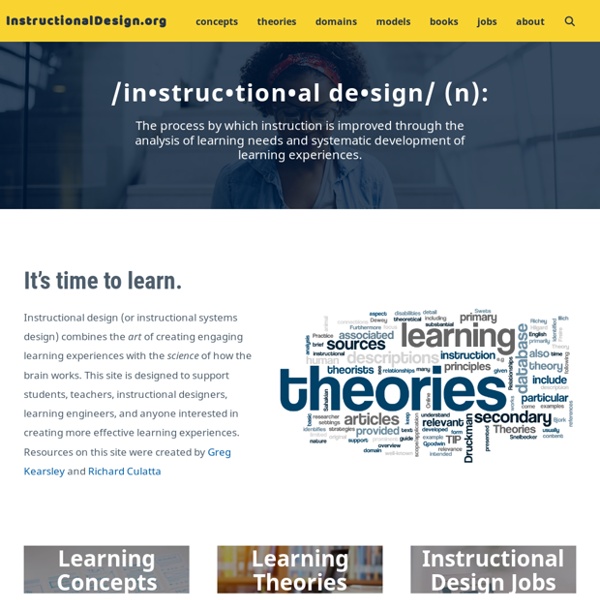



http://www.instructionaldesign.org/
Instructional Design Models The following is a list of prescriptive instructional design models. Prescriptive models provide guidelines or frameworks to organize and structure the process of creating instructional activities. These models can be used to guide your approach to the art or science (your choice) of instructional design. Instructional Design Models Instructional Design Models Models, like myths and metaphors, help us to make sense of our world. Whether derived from whim or from serious research, a model offers its user a means of comprehending an otherwise incomprehensible problem. An instructional design model gives structure and meaning to an I.D. problem, enabling the would-be designer to negotiate her design task with a semblance of conscious understanding. Models help us to visualize the problem, to break it down into discrete, manageable units. The value of a specific model is determined within the context of use.
Instructional design Process for design and development of learning resources Instructional design (ID), also known as instructional systems design (ISD), is the practice of systematically designing, developing and delivering instructional products and experiences, both digital and physical, in a consistent and reliable fashion toward an efficient, effective, appealing, engaging and inspiring acquisition of knowledge.[1][2] The process consists broadly of determining the state and needs of the learner, defining the end goal of instruction, and creating some "intervention" to assist in the transition. The outcome of this instruction may be directly observable and scientifically measured or completely hidden and assumed.[3] There are many instructional design models but many are based on the ADDIE model with the five phases: analysis, design, development, implementation, and evaluation.
Instructional Design Scaffolding helps to build a framework for the learners What is Instructional Design? Instructional Design is defined as “a systematic process that is employed to develop education and training programs in a consistent and reliable fashion” (Reiser, Dempsey, 2007). The 7Cs of Learning Design Toolkit This section contains an integrated set of resources for technology-enhanced learning design across discplines. The resources have all been tried and tested by participants on the University of Leicester's Carpe Diem workshops and the Open University's OULDI (OU Learning Design Initiative) project, and are organised under the headings of seven Cs: conceptualise, capture, create, communicate, collaborate, consider and consolidate. How to use the 7Cs toolkit for designing technology-enhanced learning A brief guide to using the resources in this toolkit The 7Cs e-tivities map
Instructional design: Testing application, not just knowledge It’s easy and tempting to write activities that test whether learners know something. How can we make learners use their knowledge as well? You might be familiar with Bloom’s Taxonomy. Its current form identifies six categories of intellectual performance, from remembering to creating. To make the taxonomy easier to apply, I grabbed my Unsubtle Machete of Oversimplification and in a few whacks reduced the categories to just two: Know activities ask learners to retrieve and maybe categorize or explain information.Use activities ask learners to apply information to realistic situations.
What Everybody Ought to Know About Instructional Design In an earlier post, we looked at how to build better courses by trimming out some of the content. Many of the follow-up comments and questions speak to your role as an instructional designer. In fact, it’s a question I was asked in a recent email: What is the role of the instructional designer? Course Module Evaluation Rubric A Rubric for Evaluation Online Course Modules This rubric, or instrument, should be used by course developers to develop quality online course modules. To view definitions of the terms used in Module Components, click on the linked term. Definition of terms Introduction By providing an introduction, you are offering your perspective on the content for the students.
What does an instructional designer do? In the past few months, I’ve been asked by a number of different people what an instructional designer does and how to get into the field. I love instructional design because it is a field where I am constantly learning and I have a great variety in what I do. I use so many different skills—writing, web design, graphics, collaboration, planning, plus of course how people learn. Since this question has come up more than once, I thought it would be useful to collect all the information I have emailed people privately and post it here. This will be a series of posts over the week or so. Derivation of electronic course templates for use in higher education Robin K. Hilla*, Jill W. Fresenb and Fawei Gengb
TOPYX Learning Management System Many people believe that once they have implemented their LMS/LCMS that everyone will come running to use the system. Nothing could be farther than the truth. Worse they assume that if it is “mandatory” everyone is going to access it because it is required. Thus creating a marketing strategy while you are working on/implementing your LMS is essential to build an audience and expand for future growth. Creating your marketing strategy Realize that it needs to be multi-pronged and not just one approachIdentify your audiences you need to reach – can be by department, job role, entire company, etc. – You will craft a giant message and campaign, but also create mini campaigns for maximum effectIdentify what channels of distribution you are going to use to get the messages out – will it be e-mail, the intranet (if you have one), a newsletter, flyers going to different sites (if applicable), word of mouth via ILT, social media, or a combination of these channels?